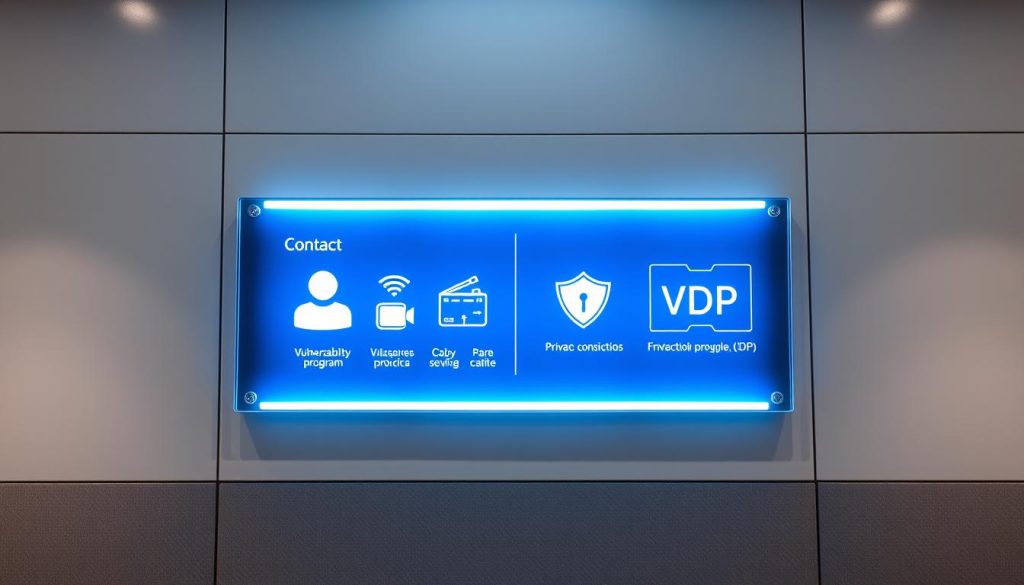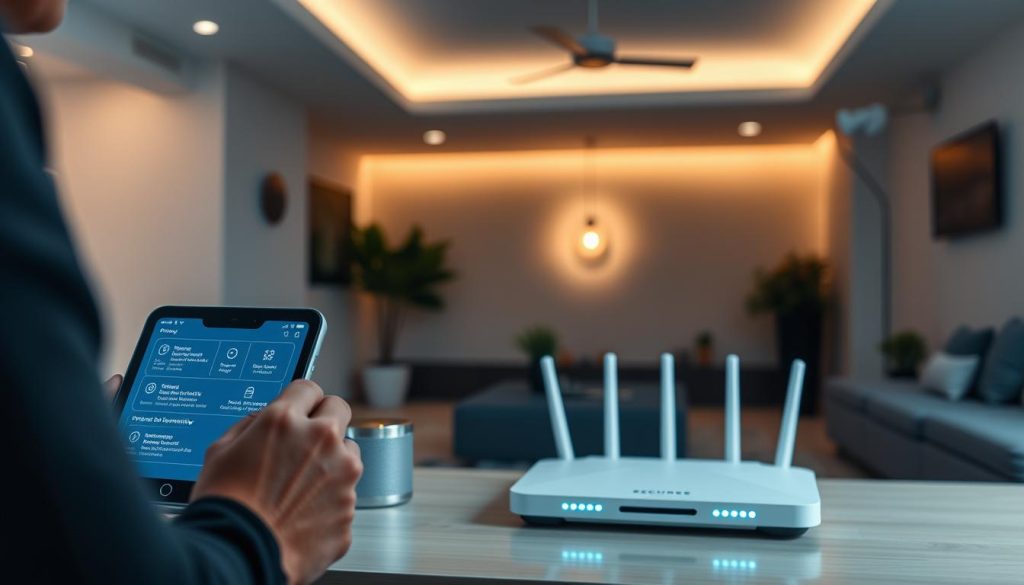You need clear, practical steps before adding any connected gadget into your home. This short guide gives you a second‑person checklist that focuses on real signals companies show when they take security seriously.
Consumer Reports found more makers now publish a security contact and a public Vulnerability Disclosure Policy. NIST and the U.S. Cyber Trust Mark push that trend further. You will learn what response times and patch cycles mean, and how standards like Matter raise the bar with unique device identity and secure onboarding.
Expect simple tests you can run on packaging, product pages, and privacy notices. We also highlight maturity markers such as bug bounties on Bugcrowd or HackerOne and safe harbor language for researchers. Knowing these signs helps you pick companies and devices that limit risks from big botnets and data sharing practices reported by EFF.
Key Takeaways
- Look for a clear security contact and public VDP before buying.
- Prefer brands that follow Matter and show third‑party testing.
- Bug bounties and safe harbor signal faster, broader fixes.
- Expect acknowledgements in about a week and patches within ~90 days.
- Balance convenience with proven cybersecurity practices for your home.
What to Consider Before You Buy a Smart Home Device
Many internet-connected gadgets quietly share more information than buyers expect. You should treat every purchase as an operational choice, not just a convenience upgrade.
EFF and independent studies show a large share of devices send information to third parties. A Northeastern and Imperial College survey found 72 of 81 tested gadgets transmitted data beyond their core function.
Botnets like Mirai and Fronton used insecure devices to launch disruptive attacks. Federal steps such as the IoT Cybersecurity Improvement Act of 2020 help, but consumer risk remains.
Aligning your needs: convenience, interoperability, and security by design
Weigh app convenience against extra data sharing. More apps and services usually mean more data leaves your home and more accounts you must manage.
Favor products that adopt security by design and open standards. Matter, for example, builds interoperability with unique device identity and secure onboarding as baseline features.
- Check privacy notices and independent reviews to see what data a product shares.
- Prefer devices that can operate locally or with limited cloud exposure.
- Look for companies that publish response timelines and patch practices; many now acknowledge reports within about a week and target fixes near 90 days.
Plan for ongoing effort. Expect routine updates, password management, and network segmentation. This time investment keeps home devices useful and safer over the long run.
How to Vet Smart Device Manufacturers for Privacy & Security
You should start by confirming two basics: a listed security contact and a public vulnerability disclosure policy (VDP). These signals show that a maker has a clear path for handling a report and expects outside researchers to help find flaws.

Response timelines and legal safe harbor
Review the VDP for timelines. Consumer Reports found many companies now acknowledge reports within about a week and often in three days. Typical mitigation windows near 90 days are common.
Check legal terms for safe harbor that avoids mandatory NDAs and promises not to pursue good‑faith researchers. If reporting requires an NDA, treat that as a red flag.
Maturity signals and quick checks
- Look for bug bounties on platforms like Bugcrowd or HackerOne.
- Find proof of third‑party testing and advisory archives.
- Confirm the maker assesses portfolio‑wide impact, not just single products.
| Signal | Meaning | Action |
|---|---|---|
| Security contact + VDP | Clear reporting path | Save link before purchase |
| Bug bounty / labs | Mature program | Prioritize these companies |
| Missing VDP | Laggard behavior | Avoid or ask for clarification |
Use these steps as a buyer filter and an ongoing checklist after purchase. Companies that publish policies and meet SLAs earn more trust from users and improve overall cybersecurity in the home.
Standards, Certifications, and Device Identity: Trust Signals That Matter
Open standards and visible certificates make it easier for you to trust what joins your home network.

The Matter approach
Matter is an open, royalty‑free standard backed by Amazon, Apple, Google, and others. The matter standard requires unique device identity and secure onboarding. That raises the baseline for security and interoperability across ecosystems.
NIST and the U.S. Cyber Trust Mark
NIST guidance highlights public disclosure and basic hygiene that align with the upcoming Cyber Trust Mark. This mark will rely on third‑party labs to validate that companies meet defined security requirements.
Attestation and certificates
Device attestation and certificates let you verify a device’s provenance at scale. Vendors such as Kudelski IoT issue Matter Device Attestation Certificates and help manage certificate lifecycle and revocation.
| Signal | What it shows | Your action |
|---|---|---|
| Matter support | Interoperable, secure onboarding | Prioritize these products |
| Certificates & attestation | Proof of genuine identity | Check docs and packaging |
| Third‑party lab reports | Independent validation | Favor clear lab results |
- Prefer products that adopt the matter standard quickly.
- Look for plain‑language notes about certificates and identity handling.
- Choose companies that publish lab tests and certificate management practices.
Privacy in Practice: How Manufacturers Handle Your Data and Connectivity
Choosing products that work with local controllers trims the signals that vendors and third parties receive. You can reduce data leaving your home by favoring ecosystems that let you run orchestration on a local hub.

Cloud dependence vs. local control
EFF recommends moving orchestration from the cloud to a local hub. Home Assistant runs on a Raspberry Pi and flags which integrations need cloud services.
Hubitat offers a commercial local hub for users who want fewer external calls. You can block outbound connections with OpenWRT or other firewall rules while keeping local features working.
Choosing privacy‑preserving radios
Zigbee and Z‑Wave form private meshes separate from Wi‑Fi. They use 128‑bit symmetric keys with CCM and pairing that resembles trust‑on‑first‑use.
Use Home Assistant’s ZHA or zigbee2mqtt with MQTT to manage local control and OTA updates without relying on vendor clouds. Many products still need internet access for firmware fixes, so plan update windows.
| Area | Benefit | Action you can take |
|---|---|---|
| Local hub (Home Assistant/Hubitat) | Less data leaves your home; more visibility | Run local integrations; block outbound for local‑only devices |
| Zigbee / Z‑Wave radios | Mesh networking; limited Wi‑Fi exposure | Use ZHA or zigbee2mqtt; prefer radios for lights and sensors |
| Firmware updates | Critical fixes that reduce risk from attacks | Allow periodic internet access or schedule controlled update windows |
| Network segmentation | Limits blast radius if a product is compromised | Isolate home devices on VLANs and enforce firewall rules |
- Test whether a product accepts local commands when internet is off.
- Verify what information companies collect and how long it is retained.
- Expect manufacturers must document connectivity modes, update practices, and local control options.
Conclusion
By 2025, many companies publish clear reporting contacts and public VDPs, and that change helps you make better choices.
You should favor manufacturers that acknowledge reports quickly and patch within about 90 days. NIST guidance, the U.S. Cyber Trust Mark, and the matter standard push makers toward measurable baselines.
Device attestation and certificates from vendors such as Kudelski IoT strengthen identity and provenance. That reduces risk from common attacks and makes interoperability easier.
At the end, pick home device manufacturers that show transparent roadmaps, support local control, and respect customer data. Keep a short checklist and calendar reviews so your consumer tech stays current and your household stays safer.

